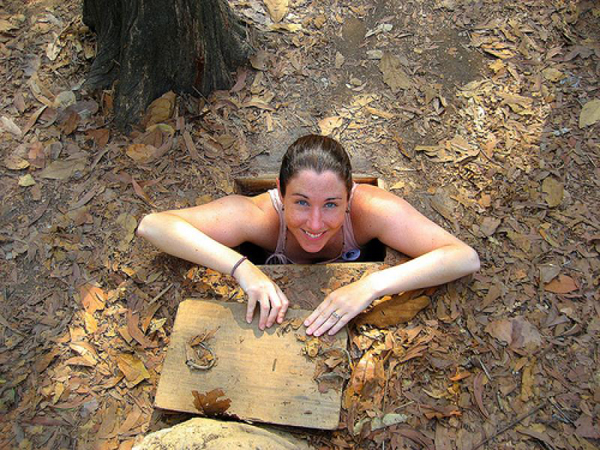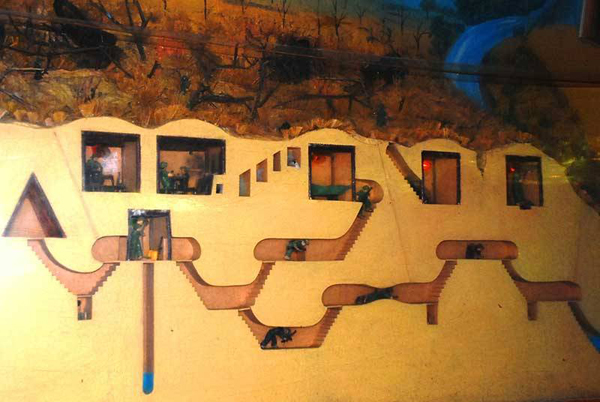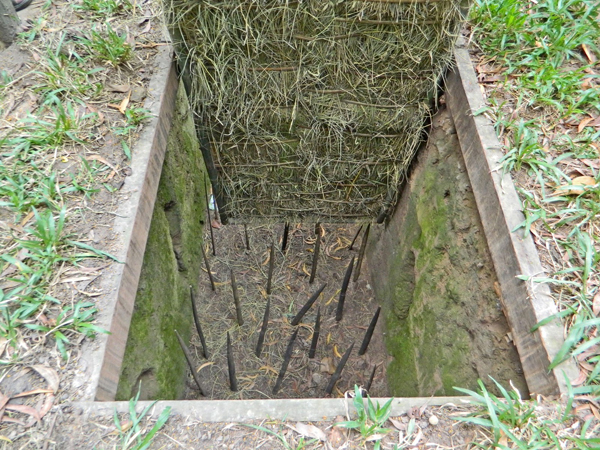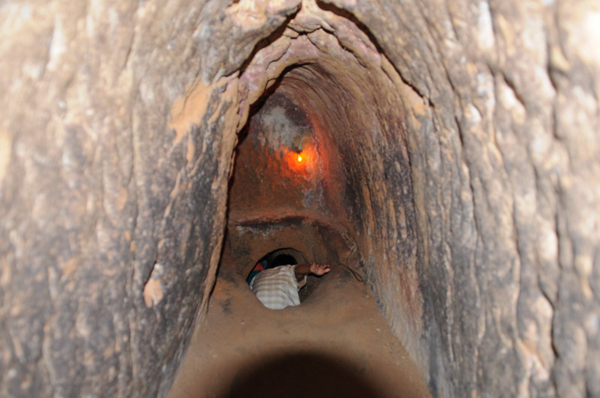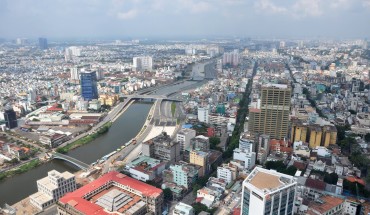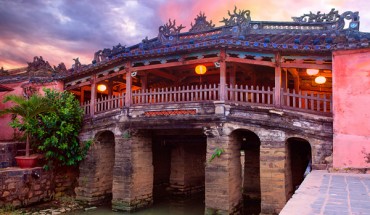Origin of the tunnel
During these years of resistance against the French (1945-1954), the revolutionaries hide under the secret bunker in enemy territory and they are sheltered, protected by people. Secret Tunnel is constructed in many ways, but mainly is in the ground with only way for breathing and in or out. It is really difficult for the enemy to find out once it is closed. The revolutionaries live in enemy territory; they keep stay on the shelter underground secret during day time and only night off the ground, go operation in the evening. However, it’s dangerous for the revolutionaries when they live in the secret tunnel if it is detected. It’s easily controlled by enemy and all people living inside will be killed or arrested. That is the reason why the prolonged secret bunkers carved into the tunnels and onto the ground with many secret doors to both shelters just fight against the enemy and escape the danger once necessary is thought. Since then, the tunnel was born and it has a special significance in combat operations, working with staff, and fellow soldiers outskirts of Saigon – Cho Lon – Gia Dinh.
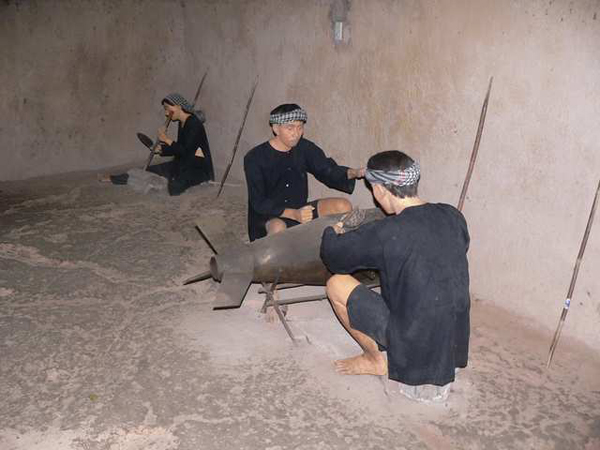
Cu Chi Tunnels were built to shelter the people and against the enemy as well as escape the dangers during American War in Southern Vietnam.
Cu Chi tunnels were built firstly in 1948 at 2 communes of Tan Phu Trung and PhuocVinh An. In the first period, Tunnel is only a short simple structure used to conceal documents, weapons, solders who lived and worked in the enemy territory. Later, it spreads to the other communes. From 1961 to 1965, the guerrilla warfare of the people in Cu Chi has grown, causing huge losses to the enemy, contributing to strategic defeat “special war” of America. In the northern communal Cu chi tunnels were completed road “backbone”. Then, organizations and communes develop branches of tunnels through the “backbone” road of the system of continuous tunnels. Entering the period against US imperialism invaded Vietnam, Cu Chi Tunnels were thrived, especially early in 1966, when the US used Infantry Division No. 1 “Red Brother” performed an operation called Crimp, sweeps, raiding bases, and the next, take the division 25 “tropical lightning” to establish bases Dong Du, consecutive sweeps tangle, raiding fierce revolutionary forces here. Before the fierce attack of America – Nguy with war destruction barbaric, District Commissioner Saigon – Gia Dinh and Cu Chi District Party Committee have led the people and the armed forces to determine to fight, kill enemies, defend the homeland, protect the revolutionary base areas of strategic importance.
With the slogan “protect our mother land, stay and fight”, the army, militia, political parties and civil authorities and the people tried to emulate digging tunnels, trenches, fortifications despite of day or night, falling bombs, bad weather, and built “firing posts” as well as set “killing perimeter to against the enemies. The movement has laid the foundation for the others from the elder to children, boys and girls participate in digging tunnels. The strength of the human will is all we need to win the difficulties. Only by very primitive and simple tools, Cu Chi‘s army and people have made a great work with hundreds kilometers of tunnels underground, connecting the stations together as a “village”. The difficulties did not stop when the small people have to transfer and hide thousands cubic meters of soil and rock to the other places to protect the tunnels from enemy’s eyes. Somebody used to wonder that how could they load and hide a large amount of soil and rock? With smart and hard-working people, nothing is impossible. There are a number of ways: filled down the deep bomb craters, plowed fields and cropped up on the land… a trace was lost in a short time. Exactly one year later, On January 8th, 1967 after the “the Crimp” campaign, the US military launched a military campaign called “Cedar Falls” to “iron triangle”, aimed at destroying the bases and revolutionary forces. This time tunnel system has reached a total length of over 200 km. Cu Chi Tunnels were not the dead tunnels, it was actively combined with the dense battlefield of mines on the ground, that has become a permanent threat to the enemy during the war.
Half Day Cu Chi Tunnel Tour.
Tunnel structure
The complicated tunnel system connected together with zigzag under the ground. From the “backbone” (main tunnels) to the smaller long branches, they all connected together or independently closed, depending on the terrain. There are many branches leading out the Saigon River that has created the emergency exits in the worse situations, and then crossed the river to the base of Ben Cat (Binh Duong).
The tunnels were not too deep but strong enough to against the heavy artillery and tanks, or small bombs. Some braches was constructed with two to three floors (upstairs called the “upper”, downstairs called “lower”). Place up and down between the floors were covered by secret hatches. The tunnels were arranged with many stops to prevent the enemy or chemical spray. There are narrow and small sections, the soldiers must be pretty neat to go through. Along the tunnels, there were many air vents above discreetly disguised and digged onto the ground with many secret gates. Countless gates are structured to be firing post and very flexible. In addition, the important tunnels were set many nail holes, pitfalls and trap spikes…
Around the important hatches were placed by landmines, nail holes, (called dead battlefields), including anti-tank landmines and anti-helicopter rockets to prevent and destroy the enemy approaching. Along with the underground tunnels are the sleeping rooms, dormitories, Ammunition dumps, foods and drinking water storage, first-aid stations, Hoang Cam kitchen (stove without smoke hid in the ground), leader’s rooms, commander’s room, surgery room, strong A-shape tunnels for women, the elderly and children. The large rooms camouflaged for meetings, film screenings, music performances… At the time of fierce combats, all the activities of the soldiers and people were “invisible” under the ground. In arduous conditions, the small people still tried to create a normal life, despite the ground with relentlessly bombing… But in reality, the life under the tunnels was extremely arduous. Because the tunnels were dark, narrow, very difficult to move, the soldiers had to bend down or crawl along the tunnels. Moreover, the tunnels were wet and stuffy due to lack of oxygen, light (light used in the tunnels was mainly candles or flashlights). Whenever a person was fainting, they were moved out the hatch. In the rain season, the ground appeared many harmful insects, even snakes … For women, the life was more difficult. Having a baby and parenting women suffered so much misery in the tunnels. Every day, hundreds of people moved up and down the tunnel that still kept secret tunnels away the enemy detection. A grass broken, soiled land or a leaf is torn unusually were recovered to overshadow the enemy.
You may interested in 1 Day Ho Chi Minh City & Cu Chi Tunnel.


